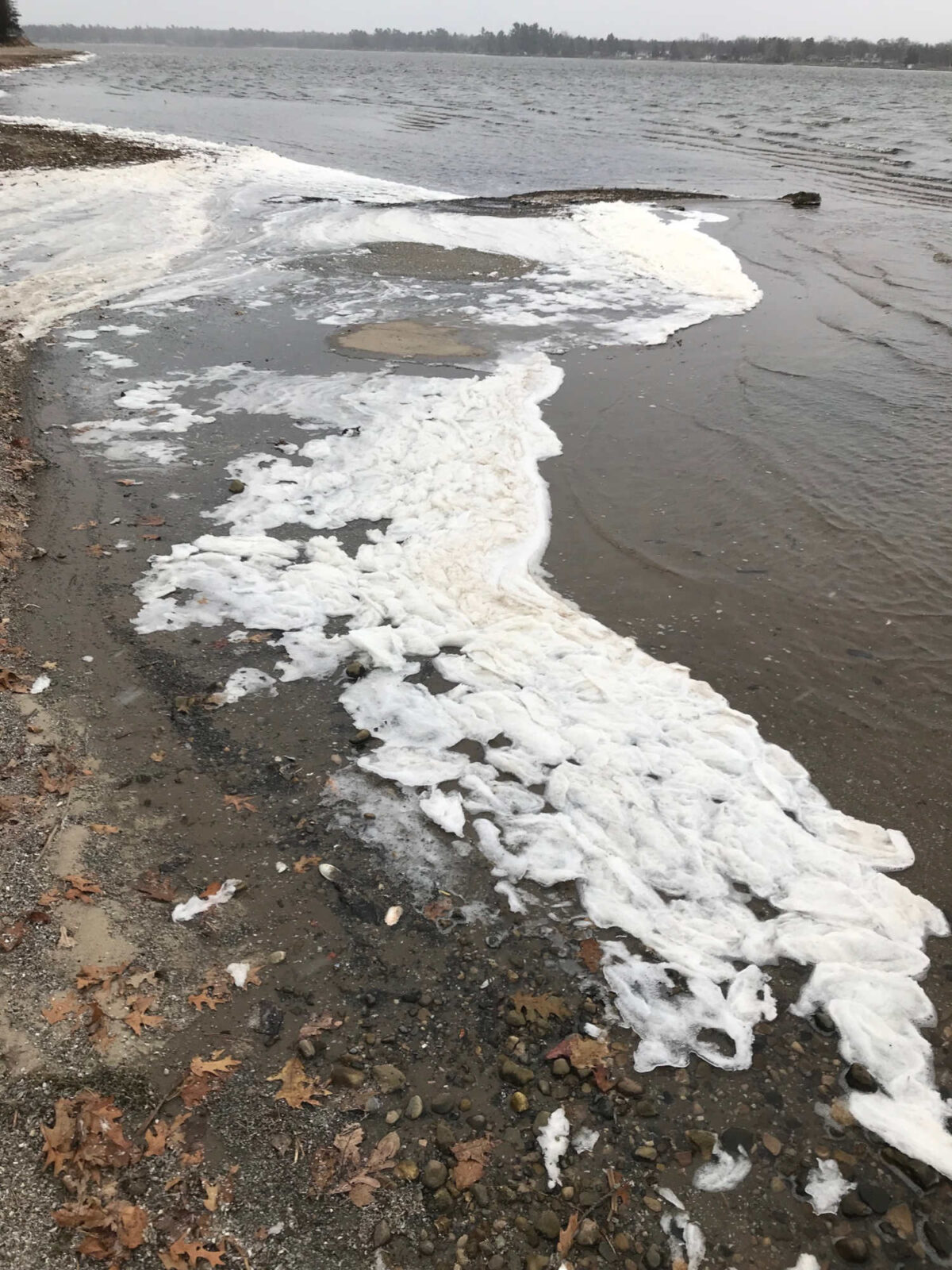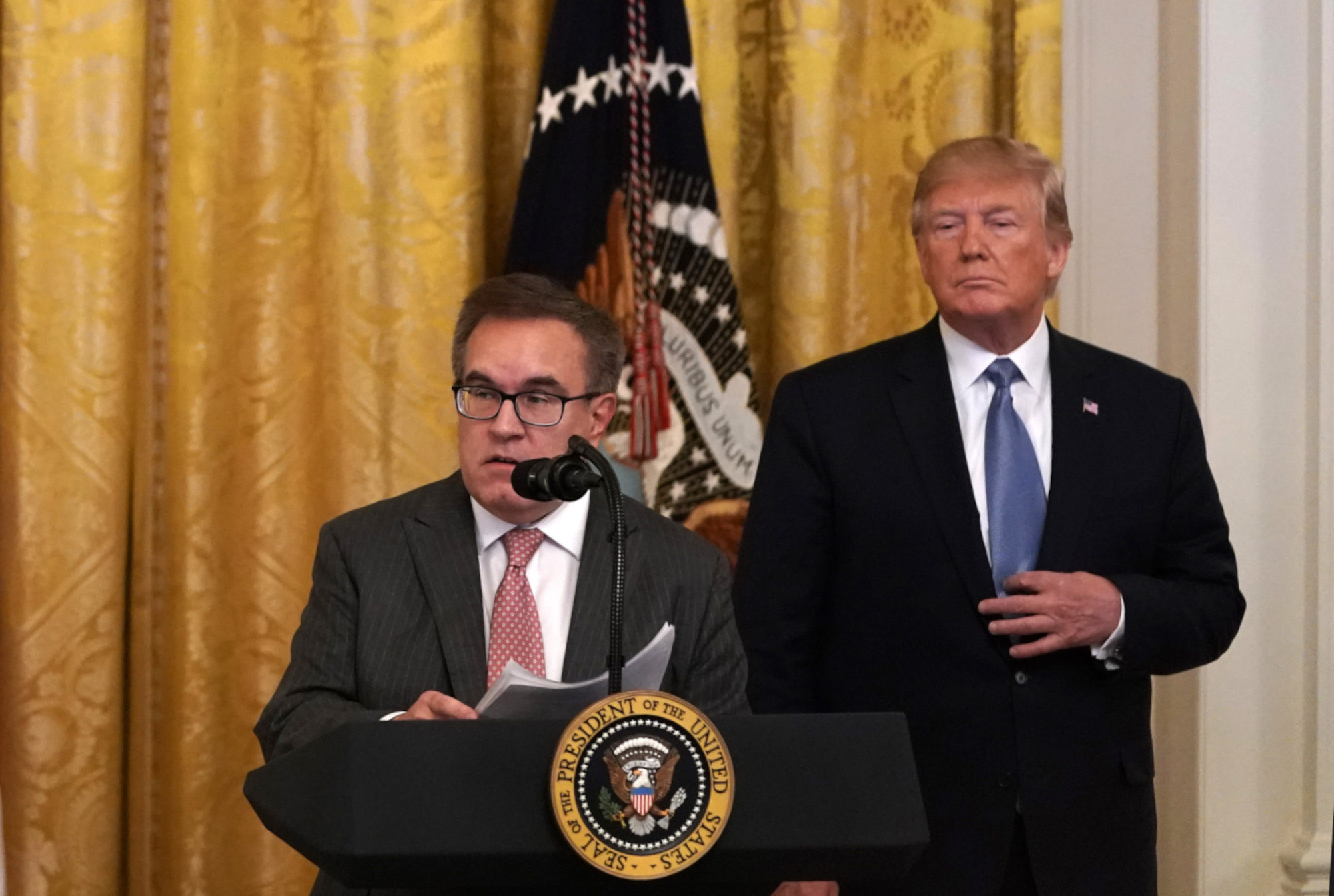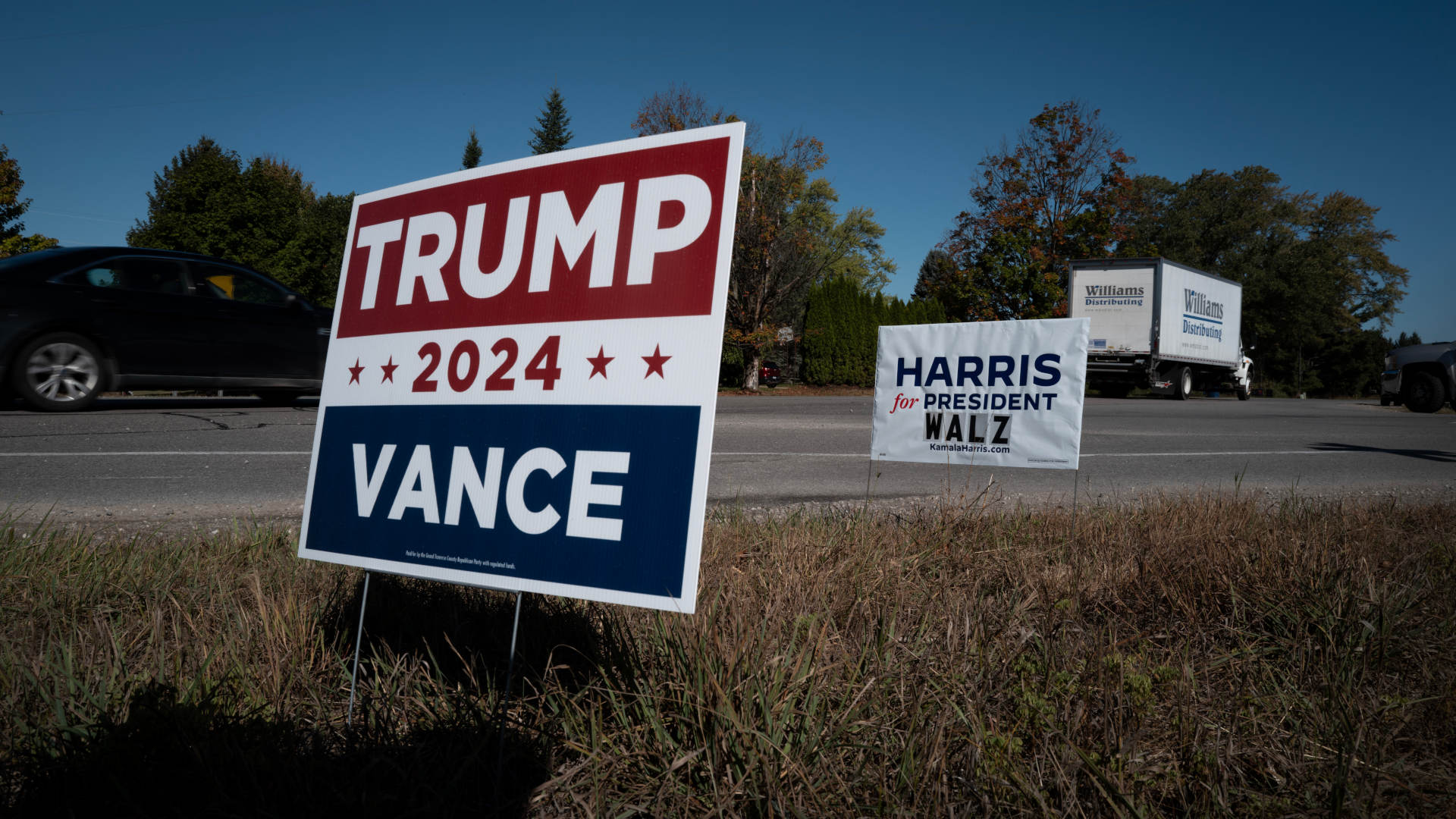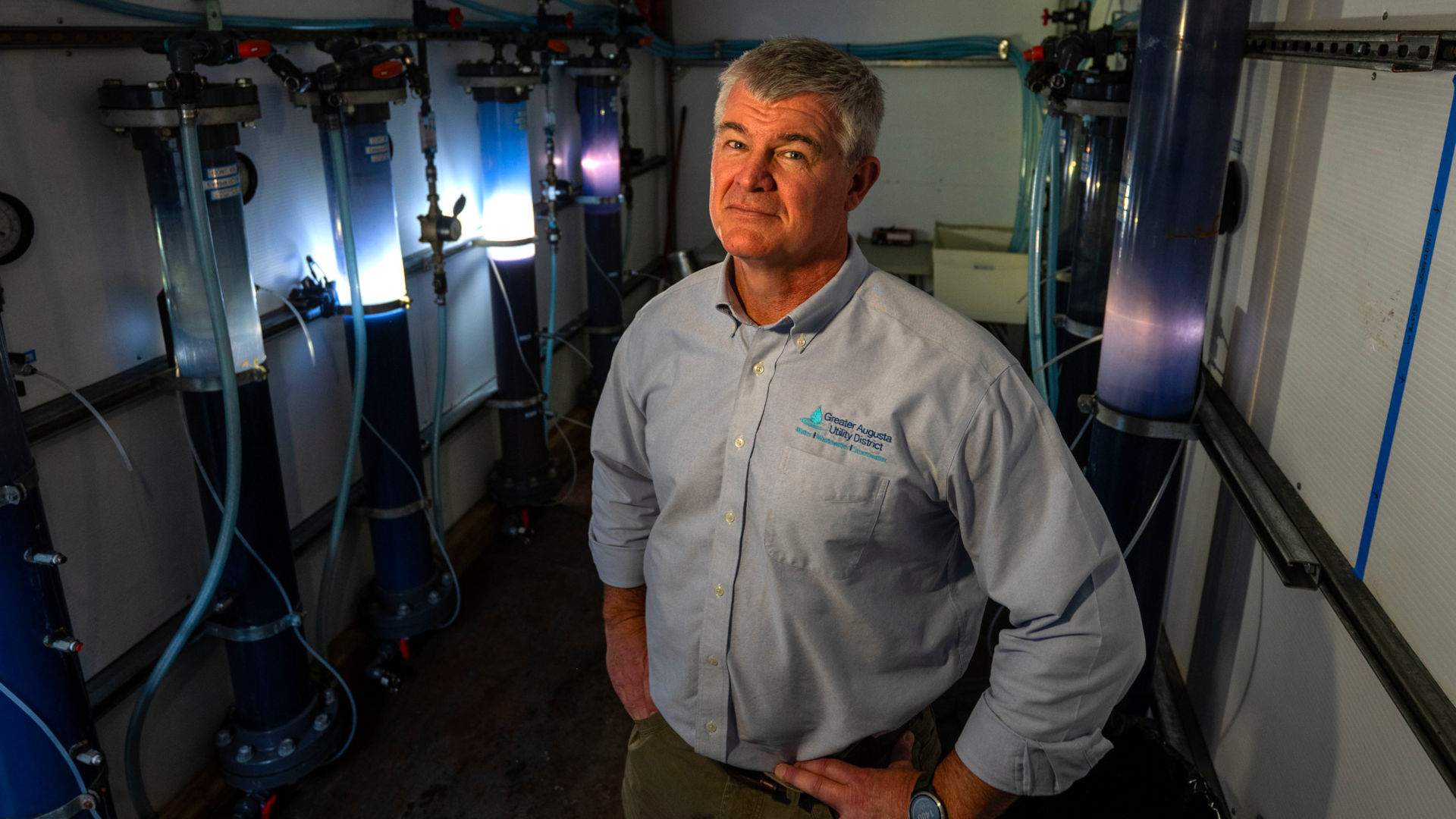How the Election Could Affect Toxic Chemical Regulation
On a chilly morning in early December 2017, attorney Anthony Spaniola awakened at his cabin on Van Etten Lake in Oscoda, Michigan, to the sight of billowy white froth bobbing along the shore. He recalled his wife peering out the window and remarking, “Hey, it snowed last night.”
“And I said, ‘I don’t think that’s snow,” said Spaniola. “It was contaminated PFAS foam.”
Thanks to their stain-, water-, and grease-resistant properties, per- and polyfluoroalkyl substances, or PFAS, have been a mainstay of commercial and consumer products for decades. Sometimes referred to as “forever chemicals” because most don’t break down naturally, PFAS (pronounced PEE-fass) accumulate in the environment and have been linked to harmful health effects, including increased cholesterol, lowered immunity, liver damage, diabetes, kidney and testicular cancer, and lower birth weight.

Foam on the shore of Van Etten Lake in Oscoda, Michigan, is contaminated with high levels of PFAS. Lake or river foam can be naturally occurring, but can also be caused by environmental pollution, which has prompted the state of Michigan to recommend avoiding foam on all waterbodies.
Visual: Anthony Spaniola
The foam on the Spaniolas’ beloved lake contains high levels of PFAS, remnants of the chemicals once used in firefighter training at nearby Wurtsmith Air Force Base, shuttered since 1993.
In the past decade, activists like Spaniola have successfully pushed for tighter restrictions on PFAS, culminating in regulations that set the first national limits on the chemicals in drinking water and require polluters pay for cleanup. Now, advocates are lobbying federal regulators to do more to limit PFAS at the source, including by banning the chemicals in certain products and helping municipalities pay for technology to filter them out of waste and drinking water.
What the upcoming presidential election, though, could mean for those policies remains unclear. The executive branch wields broad power over PFAS regulation, but neither Vice President Kamala Harris or former President Donald Trump have made PFAS contamination part of the platforms published on their campaign websites. Still, the U.S. Environmental Protection Agency’s track record during their respective administrations yields important clues about how the outcome of the presidential election could shape policy.
In advance of the upcoming presidential election, some former officials at the EPA are raising the alarm that a second Trump administration could undo progress in reducing PFAS production and cleaning up contaminated areas such as Oscoda.
“The biggest concern I would have is a rollback,” said Jennifer Orme-Zavaleta, who was an environmental scientist and administrator at the EPA for four decades. Political appointees could overrule scientists to pull back and redo regulations they didn’t like, she said. “You could end up going backwards in environmental protection.”
Orme-Zavaleta and others point to Project 2025, an initiative spearheaded by the Heritage Foundation, a conservative think tank, and featuring input from many former members of the Trump administration, which calls for efforts to “revisit” and “revise” key PFAS policies finalized during the Biden administration.
Advocates are lobbying federal regulators to do more to limit PFAS at the source, including by banning the chemicals in certain products.
In interviews, two former Trump EPA officials said that concerns about a second Trump administration were overblown — and that critics were ignoring the significant regulatory steps on PFAS taken during the Trump years. “We were moving forward in this direction on all fronts,” said Andrew Wheeler, who served as EPA administrator during the last three years of Trump’s term. Biden administration officials, he said, “haven’t opened up a new area that we weren’t already moving forward on.”
What’s clear is that the scope of the problem is staggering. A 2023 government study estimated that at least 45 percent of country’s tap water contains one or more PFAS — with far-reaching consequences for Americans’ health.
Spaniola, who today co-chairs the Great Lakes PFAS Action Network, has advocated for the cleanup of his lake and the about 300 other contaminated sites in Michigan. PFAS, he said, “shouldn’t be a partisan issue.” But Spaniola has concerns that if Trump is elected in November, the EPA could roll back regulations that, he said, are crucial for stopping ongoing contamination and cleaning up the damage.
Regardless of the election outcome, said Spaniola, “we’re not going to stop fighting and trying to forge ahead.”
Trump’s political appointees arrived at the EPA in 2017 vowing to slim down the number of environmental regulations. They soon found themselves in conflict with many of their staff scientists.
“I was really surprised, number one, at the attempts to not only undermine policy direction, but also attempts to demoralize, demean, and discredit political appointees who are responsible for implementing the vision set out by President Trump,” said Mandy Gunasekara, who spent three years as a Trump appointee at the EPA, including a stint as Wheeler’s chief of staff.
By all accounts, it was a contentious environment. “The first seven months of the Trump administration at EPA, I realized that it was going to be catastrophic,” said Betsy Southerland, an environmental scientist and former EPA official who retired after 33 years at the agency in August 2017.
“We had assumed,” she continued, “that he would just focus on killing the climate change work at EPA, and instead he went after everything.”
At least 45 percent of country’s tap water contains one or more PFAS, according to a 2023 government study.
Political appointees ushered in a “back to basics” agenda that, according to Gunasekara, focused on the agency’s core mission of protecting public health and the environment, while also listening to the concerns of industry. All told, the Trump administration rolled back more than 100 environmental regulations, according to a 2021 analysis by The New York Times.
Many frustrated career staffers retired or resigned. But despite the deregulatory focus and staff loss, the agency moved forward on PFAS — if not as quickly as some had hoped.
In February 2019, the EPA issued a formal plan for combatting PFAS. “We brought everybody together and they put forward the PFAS action plan that, quite frankly, the Biden administration is still following today,” said Wheeler.
Former EPA staffer Orme-Zavaleta credits Wheeler and his team for the cross-agency initiative that, she said, was led by career staffers with the support of political appointees. It “was a long overdue model that was then applied in looking at other issues like lead,” she said.

The problem is that those plans didn’t lead to tangible actions, said Orme-Zavaleta. In the absence of federal regulation, state governments responding to worried constituents jumped out ahead, resulting in a mishmash of standards for factors such as PFAS limits in drinking water, said Orme-Zavaleta. “They didn’t have that umbrella guidance from the federal perspective,” she said. “And I think that’s where EPA could have played a better role.”
Wheeler defended his record, noting that the EPA got the ball rolling on key PFAS initiatives such as regulations to cap levels in drinking water in the final days of the Trump administration.
The EPA’s rulemaking is necessarily methodical, said Wheeler, and the process can take years. The PFAS rulemaking under his tenure, he added, “was actually much faster than the agency has ever worked historically.”
Some of the first actions on PFAS of the Biden administration’s EPA were to undo Trump-era policies.
Shortly after Biden took office, the agency replaced a last-minute Trump-era assessment of the risk of a type of PFAS with a stricter standard. The more permissive assessment set a higher range of values for what is considered a safe amount of the chemical, which would have allowed companies cleaning up PFAS contamination to leave behind more of it in the environment, according to a 2023 report by the EPA’s Office of Inspector General. While that could be cheaper for the company, the report noted, it would also be less protective of human health.
In April of this year, the agency announced two major rules: setting a legally enforceable cap for PFAS in drinking water and designating two widely used PFAS as hazardous substances subject to legislation, known as Superfund, which requires polluters to pay for the costs of cleanup.
Wheeler pointed out that both initiatives began under his watch. With the Superfund rule, “I would love to have been there to get that through the finish line,” he said. But, he added, a lot of work went into getting the initiative as far as they did.
There has been considerable pushback on those regulations, particularly on the limit for PFAS in drinking water. The expensive removal technology required to meet that standard could be a huge economic burden to water utilities, especially in small municipalities. And not all scientists are convinced that the low limit offers clear health benefits.
Chemical companies and water utilities have filed lawsuits to challenge the ruling.
Gunasekara, who lives in rural Mississippi, wrote the section of the Project 2025 report calling for revision to the PFAS rules. In an interview with Undark, she criticized the regulation as rushed and too extreme. Many rural water associations are already behind the curve meeting infrastructure standards and lack the resources to comply, she said. “Everyone wants protections,” she said. “But if you set a standard that is unattainable from a stakeholder implementation perspective, you’re not going to see the tangible progress that everyone really wants.”
On the ground, some environmental advocates like Anthony Spaniola say they have seen more progress on PFAS under Biden than under Trump. “We saw, first, a real change in the willingness of the regulators to actually listen to us, to meet with us, to listen to our concerns,” said Spaniola. What’s come of that attentiveness is concrete action, he said, pointing to the drinking water and Superfund regulations, as well as guidance from the Department of Defense on halting ongoing contamination from groundwater around affected military bases.
Philosophically, the two administrations differed in their view of the role of the federal government in regulating PFAS, said attorney Geoff Gisler, program director with the Southern Environmental Law Center, a nonprofit environmental organization that seeks to reduce PFAS contamination by suing cities and industrial facilities to stop them from releasing the chemicals into the environment.
The Biden administration focused more on controlling the source of PFAS contamination, he said — by making rules that put responsibility for eliminating PFAS further upstream, with the companies that make and use the chemicals.
Some environmental advocates like Anthony Spaniola say they have seen more progress on PFAS under Biden than under Trump.
On the other hand, said Gisler, under Trump, “the economic and political expediency took precedence over the science a lot of ways.”
“There were still a lot of good people at EPA during the Trump administration that were trying to do good things,” said Gisler. “But the overall direction of the administration was to minimize the responsibility placed on polluters and to let them really have their way.”
So far, the candidates have said little about their plans for the EPA or PFAS regulation.
When asked about PFAS regulation in a recent interview on Wisconsin Public Radio, Harris pointed to her record as California Attorney General in enforcing rules to reduce PFAS and hold polluters accountable. “This is long-standing work,” she said, “and, frankly, a deep-seated and long-standing commitment that I have to addressing these issues, including during the time I’ve been vice president.”
Her running mate, Minnesota Gov. Tim Walz, signed one of the nation’s toughest PFAS laws in 2023, banning nonessential uses of PFAS in nearly all consumer products over the next eight years. (That kind of policy, experts say, would take much longer to implement at the federal level.)

As Trump implemented recommendations from the Heritage Foundation in his administration, some environmental analysts have looked to Project 2025 for answers about what a second term would bring. Those involved in the project include dozens of people who, like Gunasekara, served in his administration, although the candidate has disavowed any connection to the conservative playbook. Project 2025 “is a reflection of where the conservative movement is,” said Gunasekara. “Focusing on reducing the size, scope, and superfluous elements of the federal government. It has nothing to do with what President Trump may or may not do.”
Not everyone buys that. Based on her experience, Southerland, the former EPA official said, “every single thing that’s in there about EPA, I think, will absolutely be done if there is a second Trump administration.”
In her Project 2025 chapter on the EPA, Gunasekara recommends revising polices for addressing PFAS contamination in groundwater and revisiting the Superfund hazardous substance designation. She also calls for revisiting aspects of the Toxic Substances Control Act, which could affect proposed and finalized rules from the Biden era that would subject new PFAS and new uses for existing PFAS to stricter scrutiny.
Southerland, who today along with other former EPA staff advocates for progressive environmental policy for the Environmental Protection Network, fears that changes to those policies would erode years’ worth of efforts to protect the public from PFAS. The groundwater policy is so important, for example, because it governs people who draw their water from wells, she said. And the hazardous substance designation requires that companies report use of PFAS and polluters pay for the costs of clean up. Without it, Southerland said, companies could argue with the government about the toxicity of PFAS, delaying clean up for years.
Those policies should be looked at with broader stakeholder input and more diversity of scientific thought, said Gunasekara: “Yes, that takes time, but in the scheme of regulatory implementation and compliance, it would be a blip along the way.”
Ultimately, if Trump wins in November, some of the PFAS standards may change, said Gunasekara, “but it’s not going to stop tangible progress.”
Wheeler agreed: “I fundamentally believe that Republicans and Democrats agree on over 80 percent of these issues.”
Whether or not that’s the case, many advocates are more optimistic about PFAS control under a Harris presidency — even as they feel ready to work with a second Trump administration.
Regardless of the outcome of the presidential race, many environmental activists and former EPA scientists want the next administration to commit to providing financial help to water utilities to pay for the PFAS filtering technology. And they want regulators to do more to hold the industry responsible for stopping the nonessential use of PFAS and removing the chemicals from the environment.
“I fundamentally believe that Republicans and Democrats agree on over 80 percent of these issues.”
“We’re going to have increased drinking water bills and wastewater bills, and we’re going to continue being exposed to these pollutants by buying these products. So we’re getting a double whammy,” said Emily Remmel, senior director of regulatory affairs at the National Association of Clean Water Agencies, a trade group representing public wastewater and stormwater utilities. “It shouldn’t fall on you and I and the rest of the public to clean up this stuff and get it out of our products.”
PFAS cleanup, Spaniola suggested, has broad political appeal. Sticky white foam regularly piles up like shaving cream the shores of Van Etten Lake. “On the ground, people know and understand and feel the impacts of what’s going on,” he said. Knowing that the formerly pristine waters are so contaminated that you can’t eat many types of fish from there hurts tourism, a major source of the economy in the Great Lakes Region, he added, and “there’s nobody that supports that kind of thing.”











